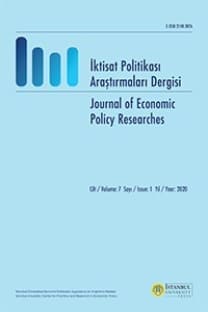THE REFLECTIONS OF HETERODOX ECONOMICS ON THE CURRENT FINANCIAL CRISIS
The current financial crisis of 2008 has caused to the emergence of different analyses in the context of the reasons of crisis both in mainstream economics and heterodox economics. This study focuses on various arguments in heterodox economics and tries to analyze them as a whole. It is worth-stressing to argue that there is no consensus on the causes and reasons of the crisis. It is hard to reach a comprehensive analysis both as theoretically and practically. Therefore in this study we will put together these different kind of arguments in order to solve this difficulty.
Anahtar Kelimeler:
xx
THE REFLECTIONS OF HETERODOX ECONOMICS ON THE CURRENT FINANCIAL CRISIS
The current financial crisis of 2008 has caused to the emergence of different analyses in the context of the reasons of crisis both in mainstream economics and heterodox economics. This study focuses on various arguments in heterodox economics and tries to analyze them as a whole. It is worth-stressing to argue that there is no consensus on the causes and reasons of the crisis. It is hard to reach a comprehensive analysis both as theoretically and practically. Therefore in this study we will put together these different kind of arguments in order to solve this difficulty
Keywords:
Heterodox Economics, Financial Crisis, Neoliberalism Financialization,
___
- [1] Blackburn, R. (2008). “The Subprime Crisis”, New Left Review, 50, March-April.
- [2] Brenner, R. (1977). “The Origins of Capitalist Development: a Critique of Neo-Smithian Marxism”, New Left Review, I/104, July-August.
- [3] Brenner, R. (1978). “Dobb on the transition from feudalism to capitalism”, Cambridge Journal of Economics, 2, 121-140.
- [4] Brenner, R. (1998). “ Uneven Development and the Long a Downturn: the Advanced Capitalist Economies from Boom to Stagnation, 1950-1998”, New Left Review, 229, MayJune.
- [5] Brenner, R. (2001). “The world economy at the turn of the millenium toward boom or crisis?”, Review of International Political Economy, 8(1), 6-44, Spring.
- [6] Brenner, R. (2004). “New Boom or New Bubble? The Trajectory of the US Economy”, New Left Review, 25, January-February.
- [7] Brenner, R. (2006). The Economics of Global Turbulance. Verso; 1st edition.
- [8] Brenner, R. (2009). “What is good for Goldman Sachs is good for America: The origins of the current crisis”, Center for Social Theory and Comparative History, UCLA, 18 April, Online: http://www.sscnet.ucla.edu/issr/cstch/papers/BrennerCrisisTodayOctober2009.pdf
- [9] Bukharin, N. I. (2009). Emperyalizm ve Dünya Ekonomisi. Kalkedon Yayıncılık, 1st edition, İstanbul.
- [10] Foster, J. B. (2006). “Monopoly-Finance Capital”, Monthly Review, Volume 58, Issue 07, Decembe
- [11] Foster, J. B. (2007). “The Financialization of Capitalism”, Monthly Review, Volume 58, Issue 11, April.
- [12] Foster, J. B. (2008). “The Financialization of Capital and the Crisis”, Monthly Review, Volume 59, Issue 11, April.
- [13] Foster, J. B. (2010). “The Financialization of Accumulation”, Monthly Review, Volume 62, Issue 05, October.
- [14] Glyn, A. (2006). Capitalism Unleashed: Finance Globalization and Welfare. Oxford University Press, 1st edition.
- [15] Hilferding, R. (2006). Finance Capital: A Study of the Last Phase of Capitalist Development, Routledge, Reprinted edition of 1981.
- [16] Itoh, M and Lapavitsas, C. (2012). Para ve Finansın Ekonomi Politiği. Yordam Kitap, 1 st edition, Istanbul.
- [17] Lapavitsas, C. (2008). “Financialised Capitalism: Direct Exploitation and Periodic Bubbles”, School of Oriental and African Studies, University of London, May.
- [18] Lapatsioras, S., Maroudas, L., Michaelides, P. G., Milios, J. and Sotiropoulas, D. P. (2009). “On the Character of the Current Economic Crisis”, Online: http://radicalnotes.com/2009/04/10/on-the-character-of-the-current-economic-crisis/.
- [19] Lenin, V. I. (2006). Emperyalizm: Kapitalizmin En Yüksek Aşaması. Sol Yayınları, 11th edition, Ankara.
- [20] Magdoff, F. and Yates, M. D. (2009). The ABCs of the Economic Crisis: What Working People Need to Know. Monthly Review Press, 1 st edition, New York.
- [21] Marx, K. (2011). Kapital: Ekonomi Politiğin Eleştirisi, Vol. 1. Yordam Kitap, 1st edition, Istanbul
- [22] Marx, K. and Engels, F. (1997). Komünist Manifesto. Bilim ve Sosyalizm Yayınları, 8th edition, Ankara.
- [23] Mohun, S. (2008). “An era of rampant inequality”, Online: http://www.workersliberty.org/story/2008/05/16/era-rampant-inequality-marxists-capitalistcrisis-4-simon-mohun.
- [24] Moseley, F. (2008). “The Long Trends Of Profit”, Online: http://www.workersliberty.org/story/2008/03/19/marxists-capitalist-crisis-1-fred-moseleylong-trends-profit.
- [25] Orhangazi, Ö. (2011). “Financial vs. „Real‟: An overview of the contradictory role and place of finance in the modern economy” Research in Political Economy, Volume 27, P. Zarembka and R. Desai (eds), Emerald Group, Bingley, U.K.,
- [26] Panitch, L. and Konings, M. (2008). “US Financial Power in Crisis”, Historical Materialism, 16, 3-34.
- [27] Panitch, L. and Konings, M. (2009). “Myths of Neoliberal Deregulation”, New Left Review, 57, May-June.
- [28] Panitch, L., Gindin, S. and Albo, G. (2010). In and Out of Crisis: The Global Financial Meltdown and Left Alternatives. PM Press, 1 st edition, Oakland.
- [29] Sweezy, P. M. (1991). “Monopoly Capital After Twenty-Five Years”, Monthly Review, Volume 43, No: 7, December.
- [30] Sweezy, P. M. and Baran, P. (2007). Tekelci Sermaye. Kalkedon Yayınları, 1 st edition, İstanbul
- Yayın Aralığı: Yılda 2 Sayı
- Başlangıç: 2014
- Yayıncı: İstanbul Üniversitesi
Sayıdaki Diğer Makaleler
TÜRKİYE İÇİN İŞSİZLİK HİSTERİSİ YA DA DOĞAL İŞSİZLİK ORANI HİPOTEZİNİN GEÇERLİLİĞİNİN SINANMASI
MERKEZ BANKASI BAĞIMSIZLIĞI KAVRAMI
BELİRSİZLİK ALTINDA KARAR ALMA: GELENEKSEL ve MODERN YAKLAŞIMLAR
SATIN ALMALARIN DEĞER YARATIMINDA SEKTÖREL ETKİLER: TÜRKİYE ÖRNEĞİ
THE REFLECTIONS OF HETERODOX ECONOMICS ON THE CURRENT FINANCIAL CRISIS
